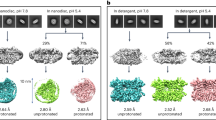Abstract
Experiments were performed to distinguish some of the proposed mechanisms by which thylakoid membranes regulate the performance of photosynthetic apparatus in relation to non-photochemical quenching, qN. Aliphatic diamines were used as uncouplers of transmembrane H+ gradient as they can be transported across the membrane at the expense of hydrogen cations. Diamines did not induce changes in low-temperature fluorescence emission but induced different changes in membrane ultrastructure. Positively charged peptides did not affect membrane ultrastructure but blocked qN. In addition, they caused an increase of low temperature fluorescence emission between 710 and 720 nm. For control peptide, the maximal fluorescence increase was found at 715 nm. Fragments of light-harvesting complex 2 in their phosphorylated and non-phosphorylated form shifted the position of this increase. We believe that peptides bind to membrane surface and reduce the mobility of membrane components whose migration is needed for observation of qN. Phosphorylated and non-phosphophorylated LHC2 fragments bind to different binding sites for corresponding forms of the protein.
Similar content being viewed by others
References
Allen, J.F.: Protein phosphorylation in regulation of photosynthesis.-Biochim. biophys. Acta 1098: 275-335, 1992.
Barany, G., Merrifield, R.B.: Special methods in peptide synthesis.-In: Gross, E., Meienhofer, J. (ed.): The Peptides. Vol. 2. Pp. 1-284. Academic Press, New York 1980.
Bennett, J.: Phosphorylation of chloroplast membrane polypeptides.-Nature 269: 344-346, 1977.
Berg, S., Dodge, S., Krogmann, D.W., Dilley, R.A.: Chloroplast grana membrane carboxyl groups. Their involvement in membrane association.-Plant Physiol. 53: 619-627, 1974.
Briantais, J.-M., Vernotte, C., Picaud, M., Krause, G.H.: A quantitative study of the slow decline of chlorophyll a fluorescence in isolated chloroplasts.-Biochim. biophys. Acta 548: 128-138, 1979.
Burke, J.J., Ditto, C.L., Arntzen, C.J.: Involvement of the light-harvesting complex in cation regulation of excitation energy distribution in chloroplasts.-Arch. Biochem. Biophys. 187: 252-263, 1978.
Cheng, L., Spangfort, M.D., Allen, J.F.: Substrate specificity and kinetics of thylakoid phosphoprotein phosphatase reaction.-Biochim. biophys. Acta 1188: 151-157, 1994.
Crofts, A.R., Yerkes, C.T.: A molecular mechanism for qE-quenching.-FEBS Lett. 352: 265-270, 1994.
Gilmore, A.M.: Mechanistic aspects of xantophyll cycle-dependent photoprotection in higher plant chloroplasts and leaves.-Physiol. Plant. 99: 197-200, 1997.
Grehn, I., Fransson, B., Ragnarsson, U.: Synthesis of substrates of cyclic AMP-dependent kinase and use of their precursors for convenient preparation of phosphoserine peptides.-J. chem. Soc. Perkin Elmer I 1987: 529-535, 1987.
Gulbrand, L., Jönsson, B., Wennerström, H., Linse, P.: Electrical double layer forces.-J. chem. Phys. 80: 2221-2228, 1984.
Hager, A.: Die Zusammenhänge zwischen lichtinduzierten Xanthophyll-Umwandlungen und Hill Reaktion.-Ber. deutsch. bot. Gesell. 79: 94-107, 1966.
Krause, G.H., Weis, E.: Chlorophyll fluorescence and photosynthesis: the basics.-Annu. Rev. Plant Physiol. Plant mol. Biol. 42: 313-349, 1991.
Krieger, A., Weis, E.: Energy-dependent quenching of chlorophyll-a-fluorescence: The involvement of proton-calcium exchange at photosystem 2.-Photosynthetica 27: 89-98, 1992.
Portis, A.R., McCarty, R.E.: Quantitative relationships between phosphorylation, electron flow, and internal hydrogen ion concentrations in spinach chloroplasts.-J. biol. Chem. 251: 1610-1617, 1976.
Rintamäkki, E., Salonen, M., Suoranta, U.M., Carlberg, I., Andersson, B., Aro, E.M.: Phosphorylation of light-harvesting complex II and photosystem II core proteins show different irradiance-dependent regulation in vivo. Application of phosphothreonine antibodies to analysis of thylakoid phosphoproteins.-J. biol. Chem. 272: 30476-30482, 1997.
Ruban, A.V., Rees, D., Pascal, A.A., Horton, P.: Mechanism of ΔpH-dependent dissipation of absorbed excitation energy by photosynthetic membranes. II. The relationship between LHCII aggregation in vitro and qE in isolated thylakoids.-Biochim. biophys. Acta 1102: 39-44, 1992.
Ruban, A.V., Young, A.J., Horton, P.: Dynamic properties of the minor chlorophyll a/b binding proteins of photosystem II, an in vitro model for photprotective energy dissipation in the photosynthetic membrane of green plants.-Biochemistry 35: 674-678, 1996
Sackmann, E.: Molecular and global structure and dynamics of membranes and lipid bilayers.-Can. J. Phys. 68: 999-1012, 1990.
Schreiber, U.: Chlorophyll fluorescence yield changes as a tool in plant physiology. I. The measuring system.-Photosynth. Res. 4: 361-373, 1983.
Stys, D., Stancek, M., Cheng, L., Allen, J.F.: Complex formation in plant thylakoid membranes. Competition studies on membrane protein interactions using synthetic peptide fragments.-Photosynth. Res. 44: 277-285, 1995.
Wollenberger, L., Weibull, C., Albertsson, P.-Å.: Further characterization of the chloroplast grana margins: the non-detergent preparation of granal Photosystem I cannot reduce ferredoxin in the absence of NADP+ reduction.-Biochim. biophys. Acta 1230: 10-22, 1995.
Author information
Authors and Affiliations
Rights and permissions
About this article
Cite this article
Štys, D., Šiffel, P., Hunalová, I. et al. The Relation Between Changes in Non-Photochemical Quenching, Low Temperature Fluorescence Emission, and Membrane Ultrastructure Upon Binding of Polyionic Compounds and Fragments of Light-Harvesting Complex 2. Photosynthetica 37, 325–334 (1999). https://doi.org/10.1023/A:1007172408839
Issue Date:
DOI: https://doi.org/10.1023/A:1007172408839




